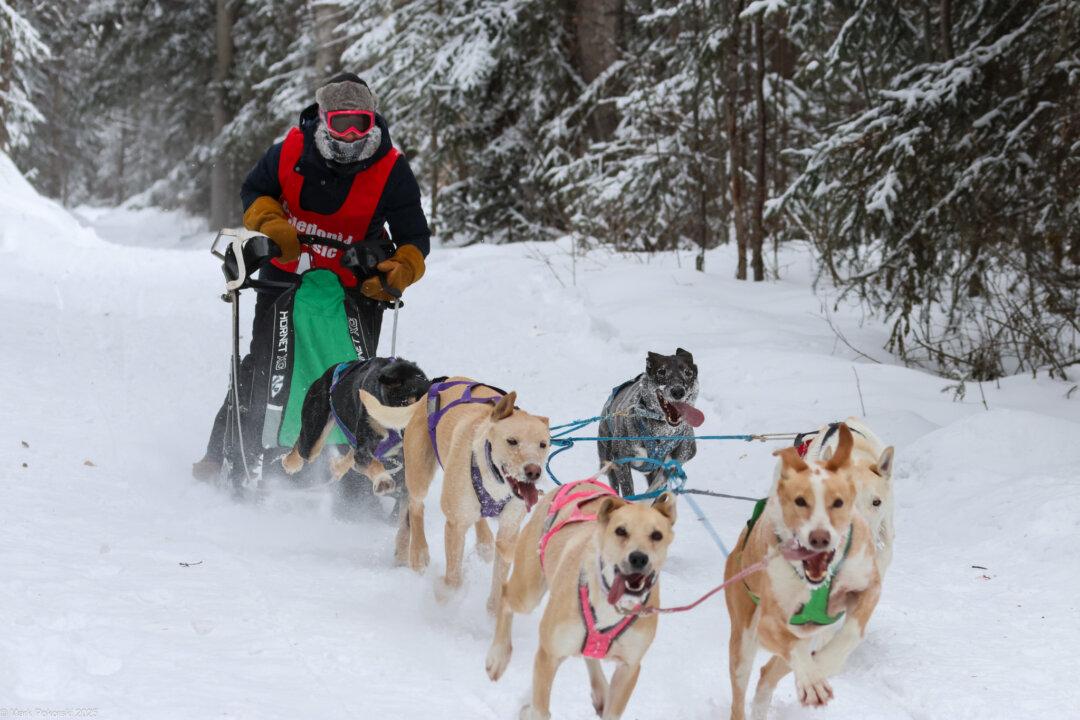For Dan Kirkup, there are few experiences that can compare with being out on a winter’s trail with his sled dogs.
“I find the dog sledding part is so peaceful,” he told The Epoch Times. “You’re out in the middle of nowhere. There’s nobody around—it’s just you and the dogs. It’s quiet, there’s no noise from an engine. … That sort of peace is hard to find in today’s world.”
Kirkup, who lives just outside Saskatoon, added that as a musher he’s very focused on the moment.
“You’re constantly paying attention to what [the dogs] are doing, where we’re going, and nothing else in life really is part of your focus,” he said.
The event also includes shorter races for teams of eight and six dogs. Over the years, the race has attracted mushers from across Canada as well as the United States, Australia, Germany, and Belgium. And it’s all through northern wilderness, where they might see wildlife like deer and get a front-row seat to a stunning display of northern lights—one of the fringe benefits of being out on the trail.
“I did a race in Yellowknife last year, and the northern lights up there were unbelievable,” Kirkup said.
The attraction to dog sledding is similar for Britta Hanks, a musher and race organizer from Fort St. James in northern British Columbia.
“I absolutely love being out in the bush by myself with the dogs,” she told The Epoch Times. “I just really enjoy the training, the camping out with the dogs on the trail, just spending time out in the bush by myself with them.”
“Our races are six and seven dogs, and so it’s doable for a smaller kennel to come to our race,” she said. “Spectators are out all weekend cheering on the teams. You can see the sprint races right from the beach.”

Besides the challenge of racing, both Kirkup and Hanks say they also look forward to spending time with other dog sled enthusiasts—people they likely only see a couple of times a year.
“You get to see friends that you talk to on the phone or on the internet, that you don’t ever see except at races,” said Kirkup.
A Challenging Hobby
Really challenging races, such as The Yukon Quest, can have mushers out on the trail for days. The race, which has been held every February since 1984, spans between Fairbanks, Alaska, and Whitehorse, Yukon, switching directions each year.The 10-dog portion of the Canadian Challenge will typically last between 32 to 50 hours. But races around the country vary; some might involve a set distance per day, with mushers able to stay in a hotel or cabin overnight.
No matter which type, it is demanding.
While mushers are generally on the sleds, when they hit hills or rough terrain they will usually hop off the sled and run alongside, or kick like you would on a skateboard, to reduce the burden on the dogs.
“It can be very physically demanding, depending on the conditions and the terrain of the trail,” Kirkup said.
On top of hours of racing, there are other challenges, like cold weather that can sap one’s energy, and a lack of sleep.
Kirkup said that while the dogs usually get four to five hours of rest every five hours, the musher gets less than that, because they have to look after everything.
“You need to feed your dogs. You generally put straw down on the snow for them to sleep on. They might have jackets … or blankets put on them. You need to eat yourself. And then you might get an hour or two of sleep, and then you get up again,” he said.
“The dogs would probably sleep four hours. … As a musher you might be lucky to get an hour.”

Accommodations can be anything from a cabin to a tent, or out on the trail.
“The musher might just pull their sleeping bag out and find a spot on the straw beside their dogs, or sleep in their sled or beside it,” Kirkup said. “The bigger issue you’re going to find with the longer race is the lack of sleep, … so mushers need to look after themselves along the trail. You know, eating, drinking, and trying to get whatever sleep they can.”
Many also enjoy carrying on a tradition that has been around for hundreds of years.
“I love being out with the dogs and thinking this is how people used to travel, you know, before we had cars and all of that,” said Hanks.
Both say it’s a hobby that requires commitment.
“It’s not like a snowmobile that you can park in the shop for two weeks because you don’t feel like riding it. This is … every single day,” Hanks said. “We get up at 5:30 in the morning to feed the dogs, and then we go to work.”
The dogs need regular exercise and, as the season approaches, regular training.
Both Kirkup and Hanks have properties outside of their home communities. Not surprisingly, both say they get very attached to their dogs.
“They are part of the family,” said Kirkup. “I like being able to take them wherever I go. … If I’ve got to run into town, I’m going to take a dog with me,” he said.
“It’s a very intense hobby, but it is so rewarding,” added Hanks.
Volunteers Vital During Races
Most races would not happen without the commitment of many volunteers, from clearing trails to handling registration.“The first part is just getting the trail in and clearing brush and trees that have fallen over. … Then it’s just packing down the snow as it comes,” said Kirkup. “So anywhere from December right up to the race.”
For the Canadian Challenge, he said, there are roughly 75 volunteers—everything from helpers staffing checkpoints to veterinarians who monitor the dogs.
“There’s no way we would be able to do it without volunteers,” Kirkup said. “It’s just too much work for any small group. We’ve got a board of eight people that look after the administrative side, and even with eight of us, we have trouble with getting everything done.”

It’s difficult to get a firm number on how many people do dog sled racing in Canada, but it’s likely in the hundreds, with many more who simply enjoy taking their teams out in the winter snow.
There are roughly a dozen long-distance races across the country. Some follow traditional dog-sled trails. For example, the Canadian Challenge started by following an old freight route between Prince Albert and La Ronge in Saskatchewan.
At the other end of the spectrum, the sprints, which usually only take a few hours at most, are the races you might see at a winter festival. Kirkup said there is one almost every weekend across Western Canada from early January on.
“There is a very strong sprint race community,” he said.
The sport is also weather-dependent. There’s been some years when the Canadian Challenge has had to alter the route because of warm temperatures, although this year there’s more snow than usual, with weeks of cold temperatures.
By contrast, the Caledonia Classic had to move part of the race off nearby Stuart Lake this year because of a lack of snow cover.
But regardless of weather, and the many other challenges, Hanks believes it’s a sport that has a solid future ahead.
“I think it’s changing, but any sport changes all the time,” she said. “There’s definitely a lot of smaller kennels popping up.”







